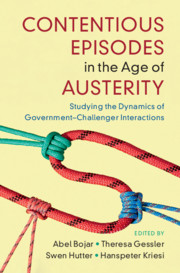 Contentious Episodes in the Age of Austerity
Contentious Episodes in the Age of Austerity from Part II - Varieties of Contention
Published online by Cambridge University Press: 05 November 2021
Portugal and Spain were among the countries hardest hit by the global financial crisis that led to the eurozone’s near collapse after the revelation of Greek public debt in late 2009. Both countries experienced a massive economic shock, as revealed by objective and subjective indicators (Chapter 3). Faced with a dire economic situation and increasing European pressure, the mainstream left in government – PS in Portugal and PSOE in Spain – announced severe austerity measures throughout 2009 and 2010 (Bremer and Vidal 2018). Consequently, the two countries saw union-organized protests against the measures early in the crisis (Accornero and Ramos Pinto 2015; Della Porta et al. 2017a; Kriesi et al. 2020; Portos 2019). Both countries experienced a turning point in 2011 when further noninstitutional actors entered the scene: Geração à Rasca [Screwed generation] in March 2011 in Portugal and 15M (named after the first large-scale protests on May 15, 2011) in Spain. According to some estimates, almost 5 percent of the Portuguese population took to the streets on March 12, 2011 (Carvalho 2018: 98). 15M and the battle cry of the central organizing network Democracia Real, Ya! [Real democracy now] led, after the first demonstration with about 20,000 participants on Puertas del Sol, to weeks of mass protests across the country.
To save this book to your Kindle, first ensure [email protected] is added to your Approved Personal Document E-mail List under your Personal Document Settings on the Manage Your Content and Devices page of your Amazon account. Then enter the ‘name’ part of your Kindle email address below. Find out more about saving to your Kindle.
Note you can select to save to either the @free.kindle.com or @kindle.com variations. ‘@free.kindle.com’ emails are free but can only be saved to your device when it is connected to wi-fi. ‘@kindle.com’ emails can be delivered even when you are not connected to wi-fi, but note that service fees apply.
Find out more about the Kindle Personal Document Service.
To save content items to your account, please confirm that you agree to abide by our usage policies. If this is the first time you use this feature, you will be asked to authorise Cambridge Core to connect with your account. Find out more about saving content to Dropbox.
To save content items to your account, please confirm that you agree to abide by our usage policies. If this is the first time you use this feature, you will be asked to authorise Cambridge Core to connect with your account. Find out more about saving content to Google Drive.